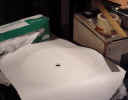
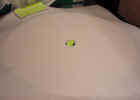
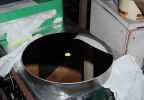
Alignment of your Newtonian Telescope will be aided by sticking an adhesive paper dot to the center of your mirror. The dot will be exactly in the center of the shadow cast by the diagonal mirror.
 |
We start with three sheets of clean paper. The first sheet we crease over the mirror edge. The second sheet we put on the table to keep whatever has been on the table from transferring to the first sheet. We cover the mirror to keep the dust off with the third sheet. |
 |
On the table we have measured from the crease and found the center of the first sheet of paper. We cut a nice round hole in the center. Back at the mirror we align the crease with the mirror edge and stick the dot in place temporarily leaving the edge up so we can adjust it. We check with the ruler and adjust the dot until it is exactly in the center. Once you press the dot down its very hard to move it without damaging the mirror coating. If its not in the center put another dot offset over the first dot. |
 |
OK, its done. Mr. Dobson has told me the bright dots are easier to see in the dark than black dots. If you are one of those high tech people with a laser collimator you might use one of those three hole binder reinforcement rings. During laser collimation the laser light will strike the center of the mirror, although in use the starlight is blocked by the shadow of the diagonal. When preparing for a laser collimator I draw a 1/2 inch square or circle on the mirror with a felt marker pen. Marker pen marks usually come off quickly in methanol. |
Installing the Coated Mirror in the Telescope
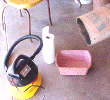 |
Clean the spider webs, deceased pill bugs, dust and other assorted stuff from the tube. |
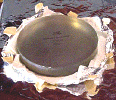 |
When unwrapping the mirror double back the wrapping tape onto itself to avoid accidentally sticking the tape to the mirror. |
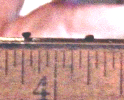 |
I prefer using a marking pen to mark the mirror center. Here I mark the center of an 8 inch mirror. |
 |
Home mirror makers sometimes don't finish the outer 1/16
to 1/8 inch of the mirror edge. To avoid scattered light from this
area I rotate the mirror on a turn table under the marking pen to mask the
edge.
Only light that will be scattered into the eyepiece field is important. Don't try to paint edge chips or scratches since the light from these areas will almost never strike the secondary mirror. |
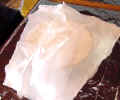 |
Whenever the mirror is waiting cover it with a lint free paper towel. |
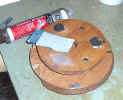 |
These aluminum foil covered pads of sealant
were made by placing six nickels in stacks of two onto the plywood backing
plate and wrapping the mirror in aluminum foil. The sealant was
placed between the coins on the sanded plywood and the wrapped mirror
lowered onto the sealant. This provided a temporary mirror cell used
for testing while making the mirror. In this picture I sand away the foil to
ready the cell for 'permanent' mirror installation.
Never glue or epoxy the mirror tight against a backing plate. Always leave at least enough space to slip a hack saw blade between the back of the mirror and the backing plate. |
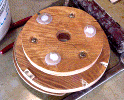 |
Sealant dust is almost impossible to remove from the mirror face without damaging the coating. |
 |
The mirror is lowered onto the sticky sealant. Then the mirror covered with a paper towel or the Kimwipe from the wrapping. Lay an old TV Guide on the Kimwipe to hold it flat. |
 |
Then I cover the whole thing with an empty bucket. Leave a little space for the air to circulate. After 5 minutes don't touch it again until the next day! |
 |
Installing the mirror. The next step will be collimation. |
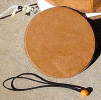 |
And don't forget the telescope cover.
If you have a space problem and it is necessary to store the telescope pointing straight up for a long time then carefully remove the mirror cell and make an aluminum foil cap for the mirror and attach with tape or rubbers bands and re install the mirror cell in the scope. |